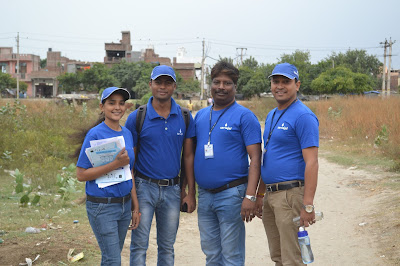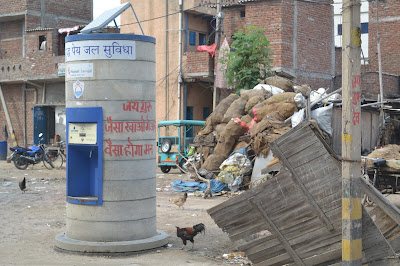In
my previous
blog post I
described how I was a WASH-newbie before arriving in Ahmedabad to start work at
Piramal Sarvajal. I had fervently set about familiarizing myself with the WASH
landscape in India and my new company’s market and model. However, I started at
a disadvantage – I am a Western transplant in India for the first time and thus
without the innate understanding of the interplay between water and culture in
my new home. (An abundantly clear example was when I excitedly announced at
lunch that I had seen a borehole well in a village and my colleagues bemusedly
explained they had grown up drinking borehole water, what was so special about
that?) Clearly, I was going to need to see Sarvajal in action to fully grasp it
in all of its complexities.
I
set out from Sarvajal headquarters in Ahmedabad on another steamy afternoon in
late October. Although I am now used to the heat, it nonetheless reaffirms the
particular urgency of our water work as I watch chai wallas and day laborers
toil away in the late afternoon sun. I was lucky enough to be able to escape to
the luxurious comfort of the air-conditioned sleeper car I had booked. Staring
out the train window at the whirring Indian vista, I lost myself in the excited
anticipation of my adventure.
I
woke up at 6am the next morning in time for the train to pull into a grimy
Delhi station. After a quick refresh, I reported for duty Sarvajal’s the Delhi
office to eagerly greet the local team. I was working with Mukesh, Vishal and
Varsha. We later met up with Ajay, one of our local plant operators.
 |
| Sarvajal Team members in the field trip |
Sarvajal’s
Delhi operations are part of a new and exciting effort to adapt our proven
rural model to the urban slums. As the worldwide trend moves toward
urbanization (about 70% of the world population is going to be living in cities
by 2030 according to Professor Jeffrey Sachs of the Columbia Earth Institute)
the challenge to create healthy, sustainable cities is becoming more
imperative. In a city like Delhi, that also means battling with the increasing disparity
between the rich and the poor. The Times of India cited a note filed before the
Indian Supreme Court reporting that 49% percent of Delhi’s population resides
in urban slums and unauthorized colonies without any civic amenities. These
bursting slums grow in the shadow of the new multimillion-dollar apartment
complexes being erected and many who share the dusty streets with the country’s
executive leadership still don’t have reliable accessibility to
safe quality water.
We
headed out to one such community, Narela, where Sarvajal has partnered with the
Delhi Jal Board in an experimental endeavor to bring clean water to the urban
poor. Narala was not what I was expected from a city slum. True, it had the
poverty, the trash, the open sewage, but it was two hours outside of Delhi by
auto. It is technically a sub-city of Delhi and felt to me like a suburb of the
city proper. (Note, it is by no means suburbia, a quick Google of the name
brings up news stories titled “Narela police station: String of murders, dumped
bodies keep police on their toes.”)
 |
| Sarvajal WaterATM in slum location |
Ajay
clearly keeps a tight ship as our Sarvajal purification plant was a clean and
inviting oasis located in the Muslim quarter. After a quick check in on the
machine health and operating status, we headed out into the community.
Sarvajal
recognized early on that you can scope the site, secure the funding and install
the water purification plant but none of that does you any good until you get
the community to buy the water! It takes some convincing to help people
understand why they should spend precious money on water, a commodity they have
been getting for free for generations. As a result, integral to Sarvajal’s
local activities are the Community Awareness Local Marketing (CALM) campaigns
where the Sarvajal team goes door to door in the local community teaching
about the health benefits of clean water, explaining the entrepreneur’s new
business and signing up new customers.
 |
| Sarvajal team's Community Awareness campaigns in Narela slum |
The
Sarvajal crew does look very impressive, going door to door in their fresh blue
t-shirts and matching caps against the dusty-brown urban backdrop. There is
even a jaunty Hindi marketing jingle to accompany the procession. The team’s
presence is greeted as a peculiar but welcome distraction. (I’m sure the
presence of a tall blonde girl in tow does nothing to belay the whole
spectacle.)
One
particularly convincing part of the CALM activities is the electrolysis test
demonstration: the Sarvajal employee asks for a water sample of your current
drinking water and uses the Sarvajal purified water for a comparison. The
electrolysis device has two prongs that get submerged with one in the household
water and one in the Sarvajal sample. An electric current is passed through the
water, burning up the dissolved solids, which turn a disgusting greenish black.
Needles to
say, seeing your water turn to sludge is a fairly convincing argument that you
need a better water source!
 |
| Seeing your water turn to sludge is a fairly convincng argument that you need a better water source |
I
was blown away by the impact Sarvajal was having on the people they serve.
Through the Hindi-translated-to-broken-English language gap, stories emerged
about healthier kids, families saving money on disease treatment, women
relishing new free time that had previously been spent waiting on the
tanker truck arrival... One gentleman told us how he travelled 6km everyday
from the outskirts of town to get Sarvajal water! He explained that has
two small kids at home and their health is well worth the daily trek.
 |
| Alessandra with some of the Sarvajal consumers |
I
spent two days with the team pounding the pavement (well, mostly dirt roads) in
Narela. We handed out flyers, talked with neighbors, gave demonstrations at the
local children’s center and at the community medical center. At one such
presentation, a group of local women spent 30 minutes drilling the Sarvajal
team with questions about the connection between drinking water and health and
about Sarvajal’s services. These people may have been forgotten by the
government, living amid squalor and beyond the reach of pipes, but they should
not be dismissed: smart and competent, it only takes a little boost, like
access to healthier water, for them to improve their standard of living and
invest in the future.
Walking
back through a field of garbage after a long day of community awareness
activities, Ajay, the local operator sighed. “I feel really proud,” he said
with a tired, though unmistakably satisfied smile. “I feel really good that I
am doing something here to better my community.”
Ajay,
I couldn’t agree more.
----Alessandra Kortenhorst
[Alessandra is a Business Development Associate Fellow at Piramal Sarvajal. Find out more about us at Sarvajal and follow us on Twitter at @PiramalSarvajal]


